A Look at Diamonds and Diamond Mining in Guyana
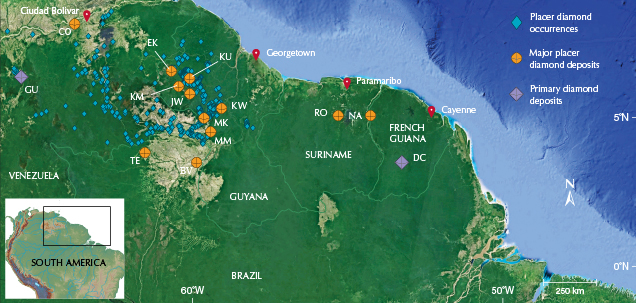
ABSTRACT
Diamonds have been mined in Guyana for more than 130 years and are traded in major diamond centers in Belgium, Israel, and the United Arab Emirates. Notwithstanding this long history, the primary source rocks of Guyana’s diamonds remain a mystery. The diamonds are likely detrital material derived from sedimentary rocks of the Roraima Supergroup, but a primary igneous, kimberlitic source has not been eliminated. Diamond exploration and mining in Guyana remain a mostly artisanal endeavor. In a similar fashion, scientific studies have rarely addressed these diamonds’ provenance and formation, and very few were aimed at a gemological audience. Here we present a detailed gemological description of Guyana’s diamonds to serve as a comparison with other diamond populations in the Guiana Shield and globally. We use our direct observations of diamonds from various alluvial deposits in Guyana. We combine government reports and datasets as well as historical accounts to provide an overview of diamond production and mining practices in Guyana. Details concerning color, morphology, nitrogen content, and luminescence are also included.
Situated on the northern edge of South America, Guyana (figure 1) is the continent’s only English-speaking nation. Originally, Guyana was populated by the first nations of Akawaio, Carib, Patamona, Lokono, Macushi, Pemon, Waiwai, Wapishana, and Warao. Dutch, French, and finally English colonialism brought advances in agriculture and technology. Sadly, these advances were also intertwined with the violent history of transatlantic slavery and indentured servitude. Laborers from Ghana, Togo, India, China, and Portugal were brought to Guyana, either by force or voluntarily. The colonial economy was based on the cultivation of sugarcane throughout the nineteenth and twentieth centuries. Guyana’s legacy of colonialism has been one of violence, racism, and poverty, which peaked during the social upheavals of the 1960s (Spencer, 2007). It has been difficult for Guyana to fully divorce itself from its colonial past. However, Guyana today is a peaceful and diverse mix of cultures and ethnic groups from around the world. This little melting pot of different languages, clothing styles, cuisines, traditional dance, and music has birthed a culture that is distinctly Guyanese (Rodney, 1981; Ishmael, 2013; https://guyanatourism.com).
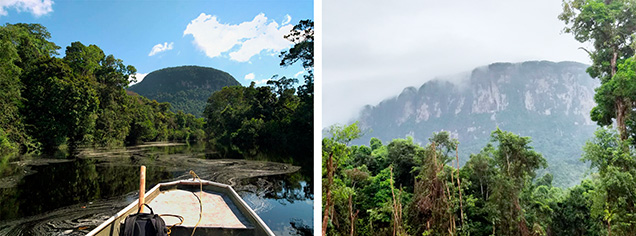
Guyana’s population is concentrated near the coastal deltas. Most of the population is engaged in agriculture, as the tropical climate, flat terrains, and fertile soils support sugarcane and rice cultivation. The scenery becomes increasingly pristine as one moves inland. Cultivated plains and infrastructure give way to tropical rainforests and rolling hills carpeted by the Amazon jungle. The country’s western boundary is dominated by the towering, flat-topped tepuis of the Roraima Mountains (figure 2). It is within the mountainous northwest where most of the diamond deposits are located. The lead author, a Guyanese native, grew up hearing about jungle diamonds found deep in the mountainous interior, a topic that sparked his imagination and scientific curiosity.

Geologically, the diamond-bearing rocks that occur in the country’s interior are part of the Guiana Shield, which is exposed over ~3,000,000 km2 along the northern margin of the Amazonian Craton (figure 3). The evolution of the Guiana Shield was dominated by episodes of accretionary mountain-building events during Archean to Proterozoic times, evidenced by outcrops of quartzite, schists, gneisses, greenstone belts, and amphibolites (Tassinari, 1997; Reis et al., 2000; Fraga et al., 2009; Kroonenberg et al., 2016). In western Guyana, the basement rocks of the Guiana Shield are unconformably overlain by the Roraima Supergroup, which is an interbedded, 2300 m thick sequence of sandstones, conglomerates, and ash-fall tuffs with an age of 2.12–1.78 Ga (billions of years), deposited from rocks eroding from earlier greenstone terranes (Priem et al., 1973; Santos et al., 2003). Paleoproterozoic mafic dikes of the Avanavero Suite crosscut the entire Roraima Supergroup sequence.
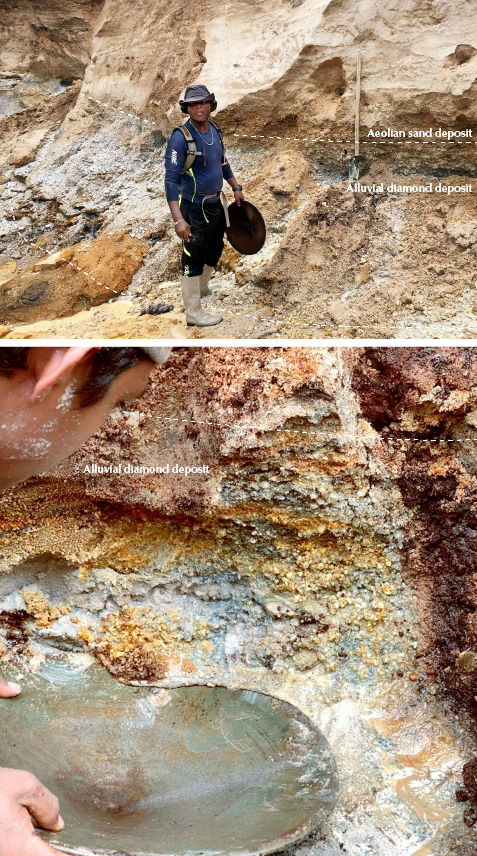
Throughout much of the Phanerozoic (the time since the Cambrian ~541 million years ago), the region has been a stable craton, only modified by erosion and deposition of sedimentary sequences. The Upper Proterozoic was marked by a period of uplift with no evidence of sedimentation (Gibbs and Barron, 1993). Since the late Triassic, drainage patterns and depositional systems have evolved in response to faulting and rifting associated with the opening of the Atlantic Ocean. Where cratonic igneous and metamorphic rocks are buried, Guyana’s jungle interior is underlain by a complex network of high alluvial, terrace, alluvial flat, riverbed, buried channel, and plateau deposits (figure 4). These repeated cycles of erosion and deposition have led to complex diamond placer deposits with variable provenances and timing.
GUYANA’S DIAMOND PRODUCTION
According to the Guyana Bureau of Statistics, mining accounted for ~12% of the country’s GDP from 2000 to 2019. Gold is by far the most important mineral resource, accounting for ~82% of all exported ore resources by monetary value. Diamonds are third most important and currently account for 2% of all exported ore materials (second is bauxite at 16%). Historically, diamond production is intimately tied to gold mining because both tend to be found in the same alluvial deposits. When gold prices are low, miners tend to extract more diamonds, which is one explanation for the cyclical nature of diamond production in Guyana (figure 5).


Although it is not well publicized, Guyana has contributed to the global supply of diamonds for more than 130 years. Their trade name has been “British diamonds,” hinting at the country’s colonial past (Persaud, 2010). In the twenty-first century, Guyana’s declared diamond production has averaged ~68,000 carats per year (figure 5). In 2004, Guyana recorded its highest production to date of 445,540 carats. From 2008 to 2012, there was a steady decline in production, likely exacerbated by financial challenges associated with the 2008 global financial crisis. After 2012, there was a steady increase in diamond production. Production today, however, remains relatively low, which can be attributed to rising gold prices (figure 5). With a historical average price per carat of US$175 (figure 6), Guyana’s diamonds remain fairly profitable when compared to the global average price per carat of US$151 in 2020 (figure 6, left). They fall within the per-carat price range of diamonds from Sierra Leone (US$186) and Botswana (US$148) (figure 6). Declared diamonds are taxed at a 3% royalty and 2% withholding tax (Guyana Geology and Mines Commission, https://ggmc.gov.gy/law/all).
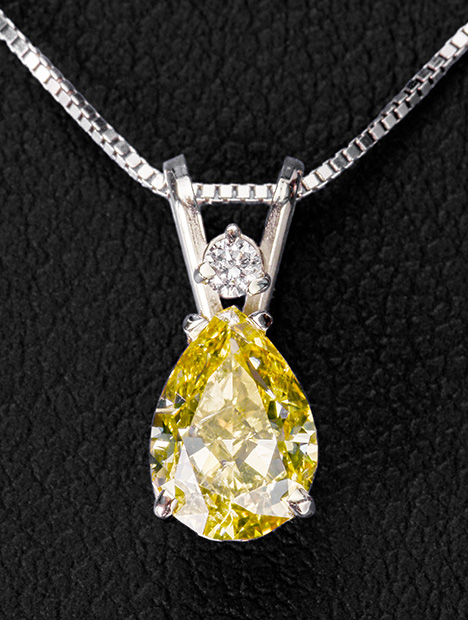
There remains room for expansion and increased production. Marketing is one such possible avenue to growth. From the 1920s to the 1980s, Guyana’s production was limited mostly to rough diamond sales in the UK, Trinidad, and Barbados (Lee, 1981). Since the 1990s, a growing number of Guyanese-owned and operated manufacturing houses have started to polish and set diamonds into beautiful pieces (figure 7).
DIAMOND MINING IN GUYANA
Diamond exploration has been driven mostly by Guyanese artisanal miners who prospect along riverbanks for unconventional, and locally specific, detrital indicator minerals to which they ascribe fanciful names. “Sweetman,” “cantankerer,” “blue jacket,” and “tin” refer to waterworn quartz, ruby, sapphire, and rutile, respectively (figure 8). Other diamond indicator minerals include topaz, jasper, zircon, ilmenite, gold, tourmaline, minor garnet, and chromite (figure 8). The Guyana Geology and Mines Commission (GGMC) is the regulatory body that oversees mining, safety, environmental protection, and education in diamond mining and geology. Although this resource is available, most miners are not well educated in prospecting or alluvial processes. Instead, they frequently rely on anecdotal evidence and superstition, only prospecting in areas that have produced diamonds in the past. The result is that the discovery and exploitation of new diamond deposits is very rare. Regardless, production has continued to provide income for artisanal miners for more than 100 years since the first discovery of diamonds in 1887 on the Potaro River (Lee, 1981).
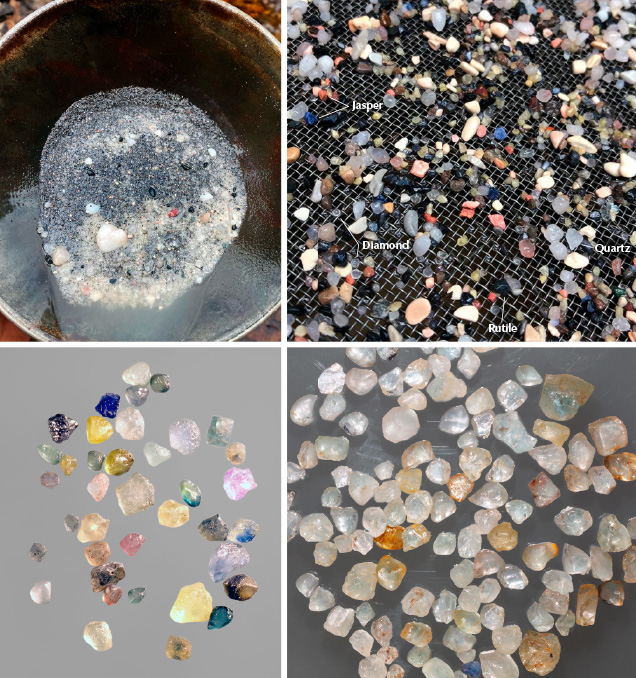
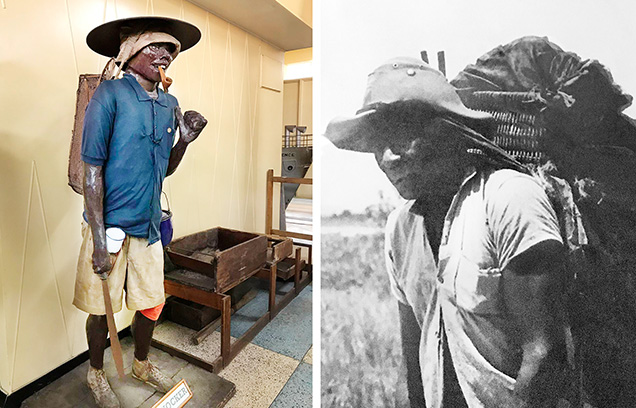
Artisanal mining in Guyana was born in the decades after the abolition of slavery in 1838. Many freed slaves of predominantly West African heritage sought a livelihood away from the sugar plantations and their former slave owners (Josiah, 2011). Prospecting and hand mining for gold and diamonds in the relatively unexplored and undeveloped interior offered both literal and metaphorical independence. Toward the end of the nineteenth century, these artisanal miners were called “pork knockers” (figure 9). This nickname is likely a creolization of “pork noshers,” a label applied to artisanal miners because of their consumption of salted and cured pork. It is theorized that a predominantly Jewish diamond merchant class coined this term (J. Krakowsky, pers. comm., 2019). Legendary pork knockers, spinning tales of fist-sized diamonds and hills topped with gold, have stirred the public’s imagination. The stories of Makantali, who wore all white and flung money into the air when arriving at the port of Bartica, and Gold Dawg, who became the first person in his village to own a car (Bascom, 1996), add enchantment to the mining industry in Guyana even today.
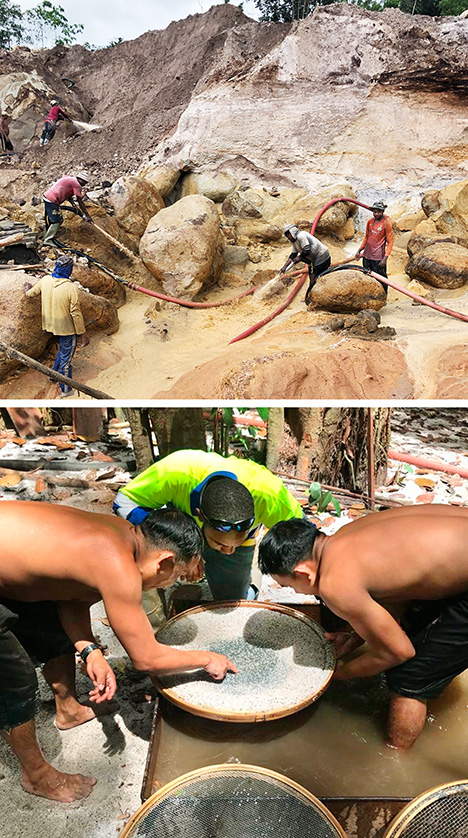
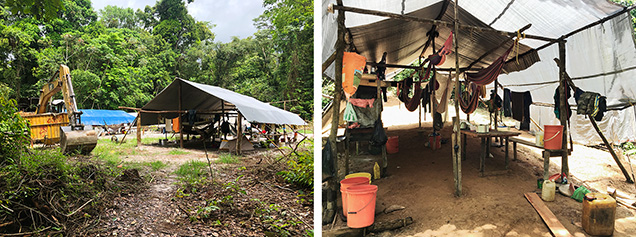

Artisanal “pork knocking” today is typically a small-scale, independent or cooperative effort. Operations are conducted on a tribute basis, where an artisanal miner receives a share of the proceeds. These miners divert water channels using mud and wood dams. Pickaxes and shovels are used to move prospective diamond gravels into manmade ponds screened with 0.2–1.0 cm sieves. Sediment <0.2 cm is discarded into the holding ponds. The artisanal miners also excavate small pits of 6–7 m depth that are shored up using cut timber (Lee, 1981). Larger groups of miners may form collectives and syndicates. Alternatively, claim owners contract small teams to prospect alluvial deposits. Individual miners are sometimes paid a salary, but diamonds are often used as currency in the jungle for purchasing fuel, services, and food (Persaud, 2010). Complementary activities that support the mining industry include food service, bookkeeping, and cleaning. Larger-scale ventures rely upon heavy equipment and techniques borrowed from the gold industry. Placer deposits are removed by an excavator and formed into a slurry using hydraulic techniques, and this slurry is then pumped to a sluice box and jig to extract both gold and diamonds (figures 10–12). Heavy minerals, including diamond, are then handpicked from the rest of the washed and sieved minerals and stored for sale (see video).
In the early years, a “bush trader” ventured into the field to sell food, liquor, and equipment in exchange for diamonds. This practice has evolved to become more stationary, where a bush trader owns a property near a port town specifically for transactions. Today, miners often carry their own diamond parcels to the capital city of Georgetown, visiting different brokers to gather quotes before confirming a sale. The economics of the diamond trade in Guyana are influenced heavily by market fluctuations, fuel supply, and the rainy season. Heavy rains in May–June and September–October significantly limit mining activity. In the offseason, miners seek alternative forms of employment in the construction, security, or food service industries. However, off-season unemployment is widespread (J. Krakowsky, pers. comm., 2019). Miners are often poorly educated on the relative value of individual diamonds in their parcels, tending to rely solely on carat weight as the metric of value. There is a need for educational outreach in this regard, where an improved understanding of how rough diamonds are manufactured into cut diamonds would improve the negotiating position of local miners.
GUYANA’S DIAMONDS
Color and Size. Economically viable diamonds in Guyana are small, mostly ranging from 0.1 to 0.4 ct. Diamonds with sizes up to 10 ct have been found but are uncommon. The largest gem-quality stones ever recovered were 56.75 and 42 ct, found in the Ewang region in 1926 and in the Perenong region in 2001, respectively (Persaud, 2010). Polished Guyanese diamonds are predominantly near-colorless, with approximately 93% of them G–J and 7% K–M, and very rarely in white or near-opaque bodycolors (J. Krakowsky, pers. comm., 2019).

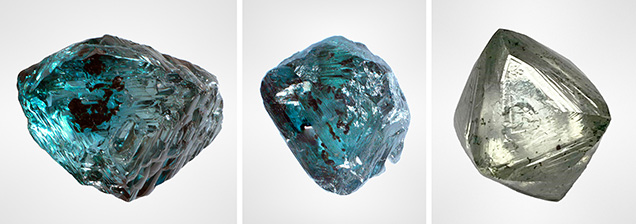
Of special note, many of Guyana’s rough diamonds (~42%) display green to green-blue skins or green spotting that covers up to ~100% of the surface area (figure 13). While diamonds with a green bodycolor are rare (figure 14) (Bassoo et al., 2021), they are relatively abundant in Guyana compared to other sources such as Brazil, Ghana, and Zimbabwe (Breeding et al., 2018). Guyana has a relatively higher abundance of green diamonds because the placer diamonds may have resided within the sedimentary environment for up to two billion years (Bassoo et al., 2021). Diamonds thus may accumulate radioactive damage over hundreds of millions of years. Alpha, beta, and gamma radiation from nearby radioactive minerals such as zircon, monazite, and potassium feldspar created vacancy and interstitial defects in the diamonds. Photoluminescence spectroscopy reveals these vacancy defects to have a zero phonon line (ZPL) at 741 nm and are classed as the GR1 or neutral vacancy (V0) defect. Vacancy defects absorb in the red portion of the visible spectrum and, in the presence of nitrogen defects, reflect/transmit green wavelengths. Furthermore, the type of radiation influences the intensity and depth of green color penetration in the diamond, with gamma radiation creating the deepest penetration of green color and alpha radiation the least (Breeding et al., 2018; Eaton-Magaña et al., 2018).

Morphology and Surface Textures. Guyana’s diamonds range in crystal shape from octahedral to dodecahedral and occasionally display flattened cuboid forms. Twinned diamonds and aggregates are rare. Fine stepped, lamellar trigonal faces are common, whereas flat faces and sharp edges are not. Resorption textures such as terraces, teardrop hillocks, and dissolution pits are found in 95% of the diamonds (figure 15). Flat-bottom dissolution pits including trigons account for ~69% of all dissolution pits and frequently penetrate into the {111} crystal faces (Bassoo et al., 2021). Most of the octahedral diamonds have resorbed edges and can be fully resorbed to dodecahedrons. Late-stage etching features such as corrosion sculptures, shallow depressions, ruts, and glossy surfaces are observed in two-thirds of the diamonds.
Edge abrasion, found in 44% of the abraded diamonds, is the most commonly observed surface texture (figure 15). Most Guyanese diamonds have some degree of surface abrasion from minor scratches and edge abrasion. Some have no apparent surface abrasion, however. This distinction subdivides Guyana’s diamonds into 85% abraded and 15% non-abraded (Bassoo et al., 2021). Abraded diamonds may reflect an older population with a long history of repeated transport within streams and rivers. Non-abraded diamonds may reflect a shorter distance and/or time of transport. Alternatively, the 15% non-abraded population may be derived from undiscovered kimberlites or lamproites (Bassoo et al., 2021). Abraded and non-abraded diamonds also display differences in luminescence.

Luminescence. Guyana’s diamonds display luminescence colors of blue, green, orange, yellow, red, and turquoise (figure 16) (Bassoo et al., 2021). Of 472 diamonds, the abraded diamonds dominantly show green to turquoise (~60%) and some blue (~20%) cathodoluminescence responses. Non-abraded diamonds cathodoluminesce predominantly blue (~60%) and moderate green to turquoise (~25%). Ultraviolet (UV) luminescence (280–315 nm) also yields a distinction between abraded and non-abraded samples. Abraded diamonds luminesce green (~85%) predominantly with very minor orange, red, and yellow (~8%). In contrast, ~50% of the non-abraded diamonds show green UV luminescence, and a larger proportion (~45%) exhibit none at all.
Cathodoluminescence spectroscopy reveals defect changes preserved within diamonds that have resided within metasedimentary rocks for billions of years. Cathodoluminescence spectroscopy is a technique that can be used to infer primary or secondary diamond sources. Most kimberlite-derived diamonds have a blue luminescence response (Bulanova, 1995; Lindblom et al., 2005). Blue luminescence is often related to the N3 defect (ZPL ~503 nm), which consists of three nitrogen atoms surrounding a vacancy (Clark et al., 1992; Shigley and Breeding, 2013). Metamorphosed paleoplacers, such as those in Guyana, tend to preserve a smaller population of blue luminescent diamonds compared to green and other luminescence response colors (Bruce et al., 2011; Kopylova et al., 2011). Green luminescence could be related to the H3 to H4 defect, consisting of more complex arrangements of four nitrogen atoms surrounding two vacancies (H3) or two nitrogen atoms separated by a vacancy (H4) (Shigley and Breeding, 2013). A change from blue luminescence to green or other colors corresponding with a shift in ZPL from ~503 nm to higher wavenumbers has been observed in diamonds from unmetamorphosed and metamorphosed rocks, respectively (Iakoubovskii and Adriaenssens, 1999; Collins et al., 2005; Bruce et al., 2011). The Roraima Supergroup, from which Guyana’s abraded diamonds are likely derived, has been metamorphosed to zeolite and greenschist facies (Beyer et al., 2015). This observation may explain the relative proportion of blue to green luminescence response colors of Guyanese diamonds.

Composition and Inclusions. The carbon isotope composition (δ13C) of Guyanese diamonds ranges from –2.8 to –16.1‰, similar to that of Brazilian diamonds (Tappert et al., 2006). The carbon isotopic composition of Guyana’s diamonds indicates they formed from upper mantle rocks (Bassoo et al., 2021). Nitrogen contents can be as high as ~2000 ppm, with >50% being type IaAB (figure 17). A small percentage (~9%) are type IaB, having more nitrogen platelets. Type IIa and IaA diamonds are of similar abundances, within 6% of each other. No type IIb or Ib diamonds have been reported. The nitrogen type and concentration were used to derive a residence temperature of ~1120°C, indicating that Guyanese diamonds are lithospheric (Bassoo et al., 2021). Inclusion composition also indicates an upper mantle origin.
Inclusions occur in ~15% of the diamonds and have been identified by comparing their Raman spectra with those in the RRUFF spectra database (Lafuente et al., 2016; Bassoo et al., 2021). Most of the inclusions in Guyanese diamonds consist of forsterite, enstatite, and chromite, indicating the diamonds formed from peridotitic upper mantle rocks. There are some diamonds that contain rutile, coesite, and clinopyroxene, and these are interpreted to have formed from eclogitic upper mantle rocks (Bassoo et al., 2021). Raman thermobarometry of entrapped olivine and Cr-pyrope inclusions indicates internal pressures of ∼6.2 GPa, again lending evidence to their formation in the upper mantle (Bassoo and Befus, 2021). Guyana’s diamonds are typical of peridotitic to eclogitic cratonic diamonds.
COMPARISONS TO OTHER DIAMONDS FROM NORTHERN SOUTH AMERICA
Guyana’s diamonds are part of a larger story about the evolution of cratons and residence within sedimentary systems. Their morphological and geochemical features compare and distinguish them from other diamonds of the Guiana Shield in northern South America (figure 18). Important deposits occur in Brazil, Venezuela, Suriname, and French Guiana.
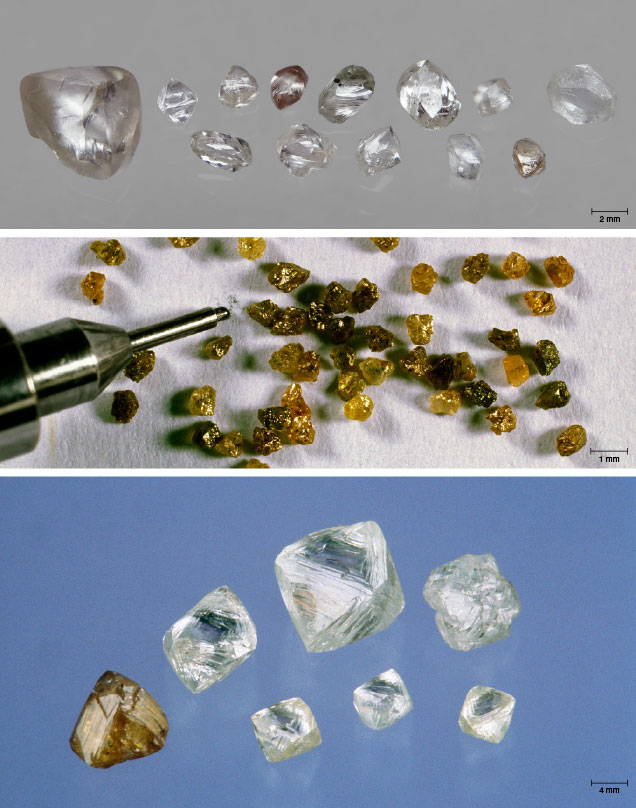
Alluvial diamonds are mined in Brazil and Suriname. In the Guiana Shield portion of northern Brazil, diamonds are recovered from alluvial terraces shed from conglomerates of the Tepequém Formation (Santos et al., 2003; Reis et al., 2017). The diamonds are generally 2–3 mm in size and occur in a flattened octahedral to dodecahedral form. They are colorless to gray, oftentimes resorbed, and contain peridotitic-type inclusions such as forsterite (Araújo et al., 2011). The Tepequém Formation represents a regional high-energy, depositional basin that was a diamond sink, synchronous with emplacement by several episodes of kimberlite volcanism within the Guiana Shield during the middle Paleoproterozoic (>2.0 Ga) (Santos et al., 2003; Schulze et al., 2006). In Suriname, alluvial diamonds are thought to be derived from rocks of the Rosebel Formation (Naipal et al., 2020). These are colorless to brown to slightly green, and green skins are common (figure 18, top). Resorption textures including trigons and frosting are common, and inclusions such as forsterite and enstatite are peridotitic. French Guiana is also home to primary diamond-bearing igneous sources, but these are metamorphosed ultramafic and pyroclastic shoshonites or lamprophyres found in the Dachine region. These diamonds are very small (~1 mm), grayish yellow to brown, irregular to cuboid (figure 18, middle), and mostly contain sulfide inclusions (Cartigny, 2010; Smith et al., 2016).
Alluvial diamond data from Venezuela is difficult to assess because illegal mining and smuggling are prevalent (e.g., Blore, 2006). Also, most alluvial deposits are located in inaccessible parts of the Amazon jungle near the Brazil and Guyana borders, where isolated Amerindian tribes such as the Yanomami are leery of outsiders (Heylmun, 2001). Further west in Venezuela is the Guaniamo area, where there exists a unique deposit of primary diamond-bearing kimberlite dikes (Capdevila et al., 1999; Channer et al., 2001; Kaminsky et al., 2000, 2004; Smith et al., 2016). Guaniamo diamonds are small, ranging from 1 to 2 mm, and colorless to gray with common green skins, frequently occurring in resorbed dodecahedrons and octahedrons (figure 18, bottom). Diamonds from Guaniamo contain inclusions of the predominantly eclogitic variety, including almandine garnet, clinopyroxene, rutile, ilmenite, pyrrhotite, and coesite (Taylor, 1999; Kaminsky et al., 2000).
CONCLUSIONS
Guyana’s diamonds are found in gravels along the eastern edge of the Roraima Supergroup. Most originate as paleoplacers from as yet unknown rocks of the Roraima Supergroup. Similar alluvial diamonds are found in nearby Venezuela, Brazil, and Suriname, suggesting the Roraima is a common source. Indeed, these paleoplacers represent a regional diamond terrane with a lateral extent of at least 450,000 km2. Diamonds from Guyana are of scientific interest because they are survivors of >2 Ga of weathering and erosion. As such, they are >2 billion-year-old xenocrysts from the mantle, brought to the surface by some of the earth’s oldest kimberlite or lamproite eruptions. They are an important source of information on the cratonic root of northern South America during the Paleoproterozoic (Schulze et al., 2006; Bassoo and Befus, 2021).
There is opportunity for expanded economic use of Guyana’s diamonds. Although small, they are valued for their lack of color and their clarity, especially as melee stones. Artisanal mining practices result in a relatively low price point, and they are not subject to prohibitive taxation. With continued exploration efforts, new paleoplacer deposits are sure to be discovered. The discovery of a primary kimberlite deposit should not be expected, but abrasion and luminescence information could indicate that some stones have experienced little transport and thermal alteration. We also recognize an opportunity for the exploration and improved recovery of other gemstones. Ruby, sapphire, and topaz are considered indicator minerals for gold and diamonds. There is no common knowledge regarding their quality or sources. Tourmaline is also present but has only been documented as schorl. Such diverse gem and mineral wealth bodes well for future discoveries in this English-speaking nation with an established gemstone mining and trade network.



